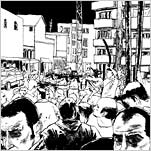In the immortal words of Yogi Berra, it’s déjà vu all over again.
Wasn’t it just four months ago that the government was racing to save the American International Group, forcing the sale of weak banks and writing huge checks to stabilize the teetering banking system? The worst was over — or so we were given to believe.
It sure hasn’t worked out that way. In November, not long after it was handed $25 billion in new capital, Citigroup was back for more — another $20 billion in bailout money and a government backstop of more than $300 billion in potential losses. This week, alas, it’s Bank of America’s turn. It came crawling back because of the huge write-down of its shiny new toy, Merrill Lynch. It got another $20 billion and a backstop against losses of $118 billion in troubled assets. There are rumors that Wells Fargo might also need more capital.
When is it going to end? Because of declining asset values, the original bailout money has largely disappeared. “It’s like putting money in a pothole that keeps getting bigger,” said Daniel Alpert, the managing partner at Westwood Capital. And it’s not over yet. Goldman Sachs says the world banking system has absorbed about $1 trillion in losses — but there is likely to be another $1.1 trillion yet to go.
The response has got to stop being so haphazard. Think about it: Citigroup is slimming down. Bank of America is bulking up. The government is essentially backing both approaches. It makes no sense.
I started wondering if there is a better approach — something that doesn’t feel like plugging holes in a leaky dike. Perhaps this new idea being discussed in Washington of creating a government bank to buy up toxic assets might do the trick. It turns out I’m not the only one who’s been asking this question lately.
“I don’t want to have to do any more of these one-offs,” said Sheila C. Bair, the chairwoman of the Federal Deposit Insurance Corporation, in an interview on Friday. “Nobody does.” She was referring to the Bank of America deal, which had been completed just days before. But she could just as well have been talking about the Bush administration’s entire approach to the financial crisis.
Think back to last September. After the A.I.G. rescue — which of course followed the Fannie Mae and Freddie Mac takeovers, the Merrill Lynch sale to Bank of America and the disastrous Lehman bankruptcy — Ben S. Bernanke, chairman of the Federal Reserve, and Treasury Secretary Henry M. Paulson Jr. concluded that they needed to find a systemic approach to fixing the huge problems in the banking system. They came up with the $700 billion bailout bill.
Do you remember the original idea for the TARP money? The government was going to use funds from the Troubled Asset Relief Program to buy up bad assets from banks and other institutions, thus taking them off the balance sheets and keeping them from dragging down the institutions. But by the time TARP became law, two things had become clear. The first was that nobody in Washington — or on Wall Street, for that matter — had a clear idea of how to value the toxic assets the government was proposing to buy. And second, the banking system had deteriorated so badly that most of that first $350 billion had to be shoveled into the banking system as recapitalizations. In addition, Ms. Bair and others forced the sale of insolvent institutions like Wachovia to healthier banks.
That initial recapitalization was necessary. Without that government-financed capital, many more banks would have been insolvent, or would have been hoarding capital, fearing future asset write-downs. But the underlying problem has never gone away. The toxic assets are still on the books. Banks still don’t really know what they are worth, so they continue to be written down in piecemeal fashion. And now, with the recession getting worse by the day, other assets, like commercial real estate and credit card loans, are going south as well. “It’s a rolling problem that gets worse as conditions worsen,” the banking consultant Bert Ely said.
(A quick reminder for readers who wonder why the banks shouldn’t be allowed to go bankrupt, like any other company that made the kinds of mistakes banks made. The answer is that the banking system is the engine of the economy; if banks stop functioning, economic activity will grind to a halt. Indeed, at least some of the pain we are going through now is the result of the banking system’s not functioning properly.)
The key point here is that any systemic solution has to deal with the bad assets, once and for all. They need to be properly valued and they need to be isolated. “How do you know how big the hole is on the balance sheet of Citi until you have a decent valuation?” asks the Princeton economist Alan Blinder. That is the primary reason the banking system can’t attract private capital and has to rely on the government — no prospective investor has any idea how deep the hole is. That will only start to become clear when these assets are either written down to zero (unlikely) or start trading again.
The second point is that the next round of recapitalization — and it now appears the next $350 billion of TARP money is going to be used primarily for that purpose — needs to encompass the entire banking system, and needs to be truly enormous. Simon Johnson, a professor at the Sloan School of Management at M.I.T., and a well-known blogger on banking issues, says he believes that it will take $1 trillion to really do the trick — money, presumably, the government will get back once the banking system is healthy again, and private capital comes in to replace the government’s capital.
“It’s not rocket science,” Mr. Johnson said. “When you do a recap, you need overkill. But then, you also have to take the bad assets off the books.” In the recent deals it cut with Citi and Bank of America, the government tried to “ring-fence” bad assets — that’s its phrase, not mine — by agreeing to absorb losses on securities that have been identified as toxic. But that is still a piecemeal, one-bank-at-a-time approach.
Mr. Blinder, a former Fed governor, told me that he thought the government should be thinking about the entire problem differently: “It should go market to market instead of institution to institution.” He pointed to actions by the Federal Reserve as a possible model: it has revived the commercial paper market by creating a commercial paper funding facility — and has done the same with several other important debt markets. In effect, it is guaranteeing the smooth functioning of those markets. And that approach has worked.
As it turns out, Ms. Bair — who, thankfully, will remain the head of the F.D.I.C. in the new administration — has been thinking along the same lines. She, Mr. Bernanke and Treasury officials have begun talking about a new kind of bank, one that would be created and capitalized by the federal government, and whose sole purpose would be to buy up bad assets. Instead of ring-fencing bad assets one bank at a time, it would warehouse them in one place, much the same way the Resolution Trust Corporation did for real estate assets during the savings and loan crisis.
Would the sale of these assets cause further write-downs? Of course. That is why you would need to throw more capital into the banks as part of a systemic solution. But at least you would finally know how deep the hole is. “You would have to mark the assets at the price they were selling for,” Ms. Bair told me. “I think that is an advantage.” At long last, there would be some certainty. Private capital won’t return to the banking system until that happens.
“The only rub in the ointment is back to the original problem: How do you determine the market price?” said Josh Rosner, a managing director of the research firm Graham Fisher. We avoided dealing with the issue in September; this time, we need to face it squarely. Senator Charles E. Schumer also worries about the total cost. “I’m hearing $1 trillion,” he told me. “That seems low.” But, he added, “if they can adequately answer that question, the idea has a lot of appeal, both on Capitol Hill and, I think, in the financial markets.”
In past financial crises, it has often been the bold and brilliant stroke that has restored confidence and revived the financial system. During the German hyperinflation of the 1920s, the government actually created a new currency. During the Latin American crisis of the late 1980s, the United States government created so-called Brady bonds, which cleverly allowed banks to get their Latin American debt off their balance sheets by turning it into tradable instruments.
And here we are again, in need of bold action and strategic thinking and the restoration of confidence. Inauguration Day can’t come a moment too soon.
This article has been revised to reflect the following correction:
Correction: January 31, 2009
The Talking Business column on Jan. 17, about continuing federal efforts to stabilize the financial system, referred incorrectly to the financial status of













